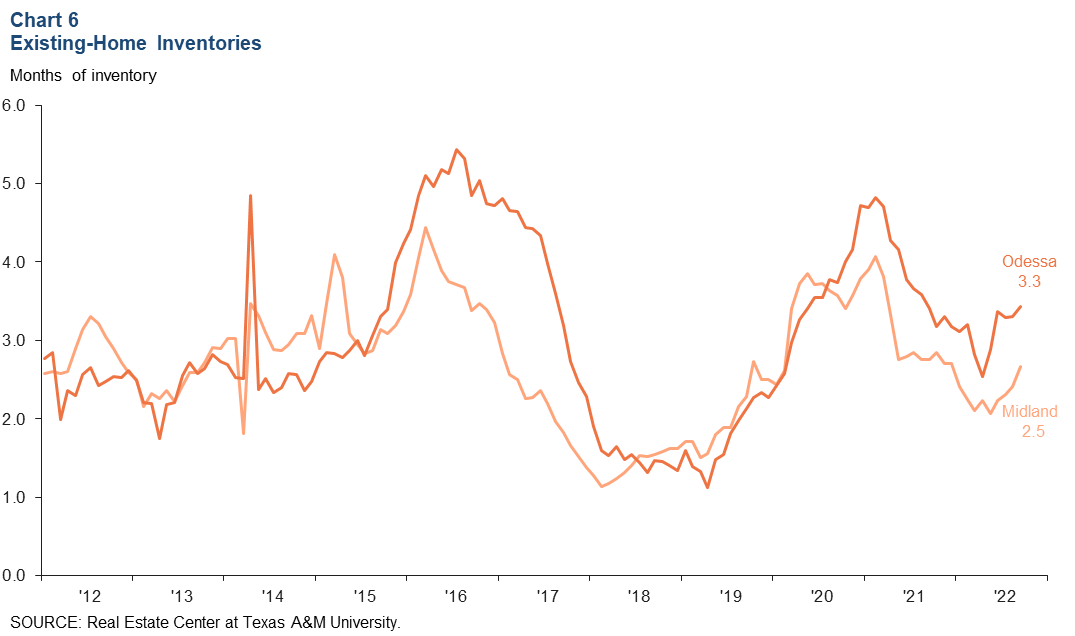Permian Basin Economic Indicators

November 9, 2022
The Permian Basin economy expanded in the third quarter but at a slower rate than the previous quarter. Both oil production and employment increased, and the unemployment rate declined. The housing market cooled due to rising mortgage rates. Because of the importance of the oil and gas industry, the Permian Basin region will likely be somewhat insulated as the U.S. economy slows.
Energy
Oil prices drop dramatically
Oil prices plunged during the third quarter. The decline was due to the dollar’s strong performance, soaring inflation rates, fears of a global economic downturn and China’s ongoing strict COVID policies. West Texas Intermediate (WTI) crude was $79.49 per barrel in the third quarter, compared with $105.76 in the second quarter (Chart 1).

Oil production climbs
Oil production in the Permian Basin continued to climb in the third quarter, reaching an all-time high of 5.26 million barrels per day (Chart 2). Meanwhile, the rig count inched down from 343 in August to 337 in September. Even with the slight decline, the rig count is still at a robust level, as rig efficiency has increased over the last several years.

Labor market
Unemployment on the decline
The unemployment rate fell in Midland to 3.4 percent and in Odessa to 4.8 percent during the third quarter. This compared with the state’s jobless rate of 4.0 percent and the nation’s rate of 3.6 percent (Chart 3).

Employment growth cools
Employment growth slowed from 5.0 percent in the second quarter to 3.6 in the third. The leisure and hospitality sector had the highest job growth at 12.8 percent, followed by government (Chart 4). Year to date, manufacturing showed the largest decline in employment, falling 9.2 percent. Professional and business services also posted a decline during the third quarter. With the third quarter slowing, year-to-date employment growth was at 4.5 percent annualized, down from 6.0 percent (annualized) in the first half of the year.

Housing
Sales and prices fall
Due to rising mortgage rates, both existing-home sales and prices in the Permian Basin declined in the third quarter. The number of homes sold rose in September but was down 9.4 percent in the third quarter compared with the second. On a quarter-over-quarter basis, the median price for a home was down 0.2 percent for the region (Chart 5). Despite the slight quarter-over-quarter median price decline, year-over-year home prices were still up 7.7 percent. The number of homes sold fell from 434 in the second quarter to 393 in the third, but there was an increase in the number of sales from 379 in August to 411 in September.

Inventories rise
Existing-home inventories started to rise in both Midland and Odessa in April and continued through the third quarter (Chart 6). However, inventories in both markets have been below four months—well below the six months considered a balanced market—since second quarter 2021.

NOTES: Employment data are for the Midland–Odessa metropolitan statistical area (Martin, Midland and Ector counties), unless otherwise specified. Energy data include the 55 counties in West Texas and southern New Mexico that make up the Permian Basin region. Data may not match previously published numbers due to revisions.
About Permian Basin Economic Indicators
Questions or suggestions can be addressed to Kenya Schott at kenya.schott@dal.frb.org. Permian Basin Economic Indicators is released quarterly.